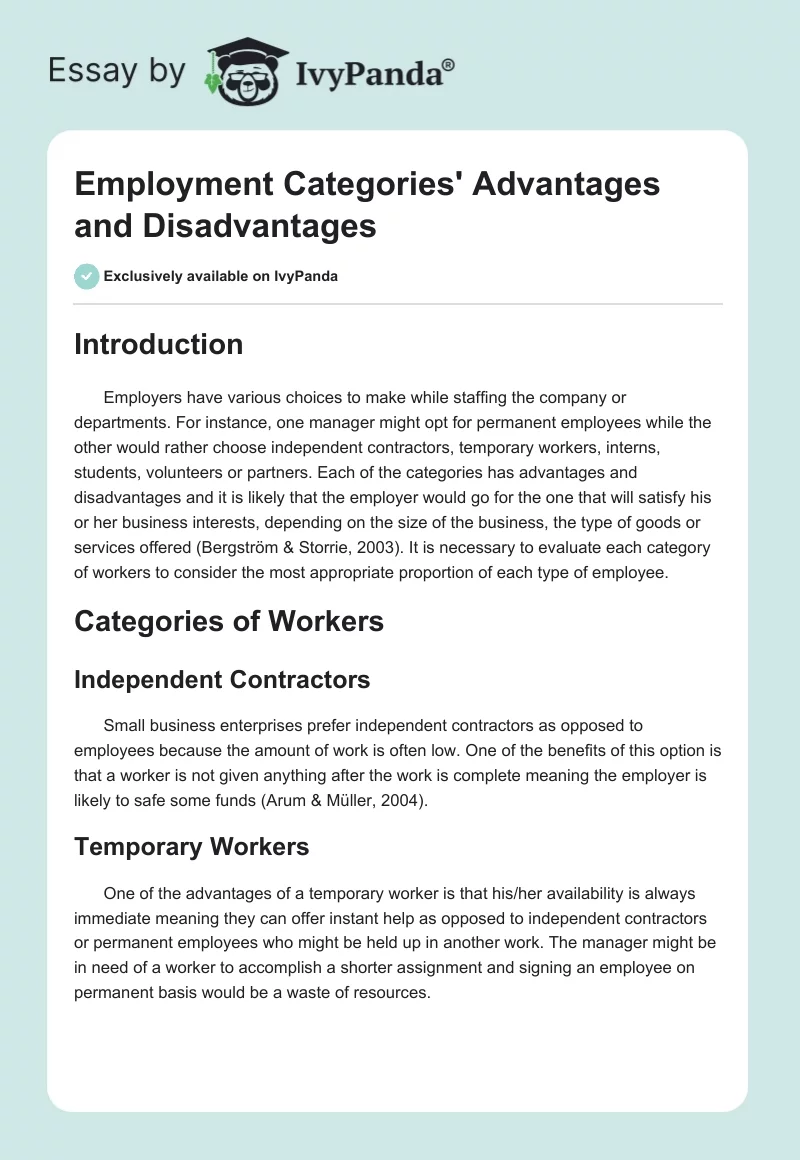Introduction
Employers have various choices to make while staffing the company or departments. For instance, one manager might opt for permanent employees while the other would rather choose independent contractors, temporary workers, interns, students, volunteers or partners. Each of the categories has advantages and disadvantages and it is likely that the employer would go for the one that will satisfy his or her business interests, depending on the size of the business, the type of goods or services offered (Bergström & Storrie, 2003). It is necessary to evaluate each category of workers to consider the most appropriate proportion of each type of employee.
Categories of Workers
Independent Contractors
Small business enterprises prefer independent contractors as opposed to employees because the amount of work is often low. One of the benefits of this option is that a worker is not given anything after the work is complete meaning the employer is likely to safe some funds (Arum & Müller, 2004).
Temporary Workers
One of the advantages of a temporary worker is that his/her availability is always immediate meaning they can offer instant help as opposed to independent contractors or permanent employees who might be held up in another work. The manager might be in need of a worker to accomplish a shorter assignment and signing an employee on permanent basis would be a waste of resources.
Students
The only advantage of hiring a student is that their labor is cheap given the fact they do not have adequate experience. Additionally, a student is flexible since he/she can do any type of work in the office. However, students are highly unreliable because they might be tired up in academics.
Volunteers
Just like students, volunteers are likely to offer short-term solutions to the employee shortage in the organization. Since they do not earn anything, the organization might save on the costs of hiring, but they will have to be trained to understand the nature of work.
Partners
Partners are the best in offering top class services to the organizational clients because they have the interests of the company. Unfortunately, they will demand for wages and allowances, which might be expensive as compared to hiring permanent employees or contractors.
Interns
While interns are good workers to cover up the positions left vacant by retiring or fired employees, an organization cannot rely on them since their availability is not known. For instance, they can be recalled to their respective stations and this would be disastrous for an organization.
Ideal Proportion for the Former Employer’s Workforce
I used to work for a small chain of bookstores. This type of employer would benefit from staffing the company with permanent workers and a small number of interns and volunteers. The proportion would be as follows: 70% of permanent workers, 20% of interns and 10% of volunteers. Thus, permanent worker should constitute the bulk of the company’s staff as they are motivated, trained, reliable and available especially if the company is selling products (Bergström & Storrie, 2003). These workers would be aware of all processes taking place in the company. Permanent workers would effectively interact with suppliers as well as clients and will be able to develop proper relationships with them. Admittedly, the employer has to provide fair salaries and motivate permanent workers to improve their performance and loyalty.
Due to scarce resources, it is possible to resort to employment of interns. The employer will pay low wages and can get quite good performance. Of course, selection of intern should be thoughtful as this category of workers are often reluctant to work hard as they need the job for their resumes only (Arum & Müller, 2004). However, if selected carefully, interns can become potential permanent workers and replace those who retire or quit.
Finally, volunteers can help the company launch a variety of promotional events. These are often charity events and volunteers can perform such tasks as giving out flyers or leaflets, meeting guests and so on. The good news is that the employer does not need to pay at all. Since such occasions are not numerous and happen rarely, 10% of the staff is sufficient.
Allocation of Proportions
As has been mentioned above, the proportion of the categories of workers depends on the type of the company. However, in the majority of cases the bulk of the staff (at least 50%) involved in such operations as management, accounting should be permanent workers as they can be aware of the processes occurring in the company (Bergström & Storrie, 2003). Non-for-profit organizations can employ volunteers (up to 80% of the staff) as they are involved in charity and people are willing to participate without any payment. Temporary workers can constitute up to 50-70% of the staff if the company provides services in construction, IT and other services and projects which are not lasting. Students should be addressed only if unskilled work is needed and the proportion of this category is often very low (around 10%) as these workers are often unable to perform numerous tasks, are not available at daytime and there can be certain difficulties concerning hiring and firing (Arum & Müller, 2004).
Conclusion
On balance, it is necessary to note that employers can consider hiring every category of workers depending on the type of services they need to be implemented.
References
Arum, R., & Müller, W. (2004). The reemergence of self-employment: A comparative study of self-employment dynamics and social inequality. Princeton: Princeton University Press.
Bergström, O., & Storrie, D.W. (2003). Contingent employment in Europe and the United States. Cheltenham: E. Elgar.


